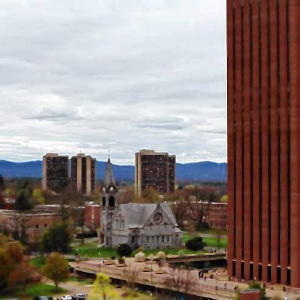A higher ed game-changer?: Could MassReconnect change college education in Massachusetts? Experts say yes
|
By Naylynn Tañón Reyes, Swaha Bhattacharya, and Tint Tha Ra Wun |
Published: 05-28-2023 12:31 PM |
NORTHAMPTON — Chuck Bayliss, now an Ada Comstock scholar at Smith College, started her own woodworking business in 2006 in Leeds via a trade program at Seattle Central Community Colleges in downtown Seattle. Due to health concerns, however, Bayliss had to change careers in her 40s.
Holyoke Community College allowed her to return to school later in life and, once again, start down a new career path. Currently, she is finishing her bachelor degree in geoscience and aspires to become an environmental geologist and writer once she graduates.
“I’ve had years of experience at community colleges,” Bayliss said. “They’ve changed my life.”
Though the experience was transformative for her, Bayliss is still in debt from her time at HCC.
Had the newly-proposed MassReconnect program been available when she was taking classes, Bayliss would have qualified to receive tuition support at community college. In March, the Healey-Driscoll administration introduced the MassReconnect program as part of its fiscal 2024 budget recommendation. The program, which is set to receive $20 million from the state’s 2024 budget, aims to make community college free for students aged 25 and older. Leaders in both the House and Senate agree on the proposed $20 million investment for the program in their respective budget proposals for next fiscal year.
But who are the students who attend community colleges in Massachusetts, and what would the MassReconnect program mean for them?
It turns out the state’s community colleges are especially important to marginalized communities. In the 2020-2021 academic year, roughly 11% of high school graduates in Massachusetts attended community colleges in the state. At least 44% of those students identified as persons of color. In comparison, on average, 28% of the population in each Massachusetts county identify as persons of color.
Nationally, half of all Hispanic and 40% of all Black students in higher education are enrolled at community colleges, according to the American Association of Community Colleges.
Article continues after...
Yesterday's Most Read Articles
 Locking up carbon for good: Easthampton inventor’s CO2 removal system turns biomass into biochar
Locking up carbon for good: Easthampton inventor’s CO2 removal system turns biomass into biochar
 Northampton man will go to trial on first-degree murder charge after plea agreement talks break down
Northampton man will go to trial on first-degree murder charge after plea agreement talks break down
 Police report details grisly crime scene in Greenfield
Police report details grisly crime scene in Greenfield
 Area property deed transfers, April 25
Area property deed transfers, April 25
 Advancing water treatment: UMass startup Elateq Inc. wins state grant to deploy new technology
Advancing water treatment: UMass startup Elateq Inc. wins state grant to deploy new technology
 Super defers Amherst middle school principal pick to successor; one finalist says decision is retaliation for lawsuit
Super defers Amherst middle school principal pick to successor; one finalist says decision is retaliation for lawsuit
“Community college plays a major role for POCs,” said Lauren Arriola, an alum of San Diego Mesa College who transferred to UCLA and now works at a community college. “In my case, it was an opportunity for advancement. I didn’t even speak English. Community college taught me to learn from my peers and their experiences. It gives the chance for POC like me to access higher education and prepare for future endeavors.”
Currently, Massachusetts is one of the states with the top 10 highest average community college costs in the nation. According to the data published by Community College Review, Massachusetts is ranked fourth for highest average community college cost in the U.S., with an average cost of $6,812. As a major access point to education, this high cost can be a barrier, say students and government and education officials, particularly for the students who need it most.
The MassReconnect program could reopen the window of opportunity to students for receiving higher education and potentially reverse recent declines in community college enrollment in the state.
POC students have defied overall enrollment trends at community colleges. While total enrollment at community colleges in Massachusetts has decreased by 37% since fall 2013, the number of POC students has declined by just 21%. More than half of that decline occurred in 2020, likely as a result of the pandemic. Enrollment has held steady since. In 2022, POC students outnumbered white students for the first time since 2013.
In Massachusetts, 700,000 residents have some college credit but do not have a degree, and many more have just a high school diploma, Delaney pointed out. The MassReconnect program is mostly focused on helping older students who started college but did not have the support to finish it.
“We think the MassReconnect program will be transformative for thousands of students in that first year and hundreds of thousands of students in the next decade,” said Delaney Corcoran, communications director at the Executive Office of Education of Healey-Driscoll administration.
California, which implemented free community college through the California Promise Grant in 1984, can serve as an example of what might happen for Massachusetts, especially for students of color. In 2016, 62% of students in California benefited from the program.
Alondra Valenzuela Aparicio, 27, a current engineering student at California State University, has said that the fee waiver in California allowed her to pursue a better future.
“I would not have gone to community college without financial aid. I would not be able to afford the costs,” Valenzuela Aparicio stated.
Low tuition costs and the availability of night and online classes are among the factors that motivate students to go to community colleges. Students with a full-time office job or a family to look after can take classes part-time or take time off as needed without additional permission from college administrators or financial penalties.
“Community colleges have always been about accessibility,” declares Stacy Fisher, a senior director at the Foundation for California Community Colleges and a former community college student.
Low-income students are disproportionately POC due to historical effects such as redlining and generational wealth disparities. The poorer a student, the less likely they may be to reach out for aid as financial aid is, impacting their choice to select a community college versus a university, as reported by Community College Review.
“The reasons for why students of color disproportionately attend community colleges is multifaceted and complex, but it is largely a microcosm of larger racialized inequities within our society,” states Stacy Teeters, a Guided Pathways Regional Coordinator supporting educational systems change at California Community Colleges.
Advisors may also have implicit bias toward POCs about their intelligence or capabilities and actively discourage them from competitive universities. Instead they funnel them toward local community colleges, as noted by The Hechinger Report.
These long-standing inequities in K-12 systems highly impact POCs’ decisions and eligibility to enroll in community colleges.
Community colleges are distinctive in the attention awarded to students. Unlike most universities, professors are not required to conduct academic research, giving them more time to concentrate on students and teaching.
“That’s what makes community colleges so special and so wonderful. They’re there for the students,” said Andrea Rossi-Redder, Dean of Transfer at Smith College.
Small class sizes are also influential in attracting students to community colleges. Flavia DePlachett, a civil engineer for the city of San Diego, like Valenzuela Aparicio, was also a recipient of the fee waiver and free community college program in California.
“Small class sizes at community college make it more conducive to learning,” DePlachett said. “At universities, lower-level classes sometimes have over 200 students, which makes it more challenging to have your questions answered and to have direct contact with the instructors.”
If the MassReconnect program is approved, it would have the potential to boost the POC community, having a lasting impact for decades to come.
“Government programs are crucial to fill in social gaps,” shared DePlachett. “They offer a bridge for minorities like me to pursue higher education and positively contribute to society.”
This story was reported and written by students in a Data Journalism course at Smith College taught by writer and journalist Naila Moreira and data scientist Ben Baumer.
 Federal probe targets UMass response to anti-Arab incidents
Federal probe targets UMass response to anti-Arab incidents William Strickland, a longtime civil rights activist, scholar and friend of Malcolm X, has died
William Strickland, a longtime civil rights activist, scholar and friend of Malcolm X, has died
